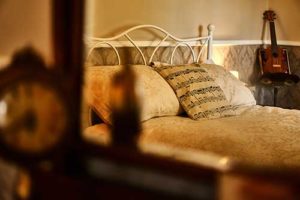 In the early morning the musician’s room is bathed in light and in the evening the bedside lamps cast a warm glow across the soft double bed, bedside tables and dresser.
In the early morning the musician’s room is bathed in light and in the evening the bedside lamps cast a warm glow across the soft double bed, bedside tables and dresser.
The rooms of The Old Victoria were first opened in 1837 – the year organist and composer, Théodore Dubois, was born and the year violinist and composer Joseph Schubert died. So it is only fitting that in its most recent incarnation, at least one room pays homage to the rich history of music.
But even as the influence of European music set is seeds in the shores of Australia, the First Nations people were locked in dance and music of a different kind. As reporter, Philip Parker King writes in his diary in the week of 6-14 March “We are detained on board all day by a heavy rain (…). Some hundreds of natives have come to the settlement with presents of kangaroos to the Governor, and tonight there was to be a corroboree (…). The dances are alike, but the song by which they are led differs at the fancy of the singer. (…) The women sit with their backs to the fire, and simultaneously beat a roll of opossum cloaks, which produces a sound something like a drum. The leader as indeed have all the dancers, has a short stick (barongain) in each hand, which he strikes together at first in slow measure as the subject of the song is introduced, the women keeping time with him on their drums. The fire at first burns dimly, and the dancers make their appearance one by one at a distance, emerging in the dark from among the bushes and trees; as the song proceeds and the subject begins to develop itself, the fire is made to sparkle, the measure quickens, the sticks and drums are beat louder and louder, and the actors advance until they gradually draw round the leader close to the fire, which now blazes up, who becoming warmed with his subject, increases the rapidity as well as force of the blows (all keeping time as if the sound was produced by a single blow), until a sign being made, they all make a sort of grunt strike their sticks once more, and then silently vanish off in a twinkling behind the bushes, and are shrouded by the darkness of the background in which they are ensconced, until a new song gradually commences and recalls them on to the stage. The whole has quite a dramatic effect. Their bodies are painted over with white stripes of pipeclay (bobal), and round the ancles are small boughs or branches of trees (kerang), which as they move make a rustling noise, which they increase with the measure of the song.”
So don’t be taken by surprise if the ambiance of the musician’s room causes your imagination to play tricks on you and you hear the sounds of a violinist drawing their bow artfully across the strings of the hollow wooden box or, better still, if you hear the distant sounds of women beating “a roll of opossum cloaks” and a sound something like a drum drifts in on the night air.
- Facilities and amenities available in this room
- Double bed
- Dresser
- Wi-Fi
- Bathroom (shared)
- Luxury toiletries
- Towels and linen included
- Laundry facilites (shared)
- Breakfast (in the Drawing Room or downstairs in the restaurant or courtyard)
- Tea and coffee making facilities, a toaster and a mini fridge are available in the Drawing Room
- Complementary port and fruit are provided in the Drawing Room on arrival
